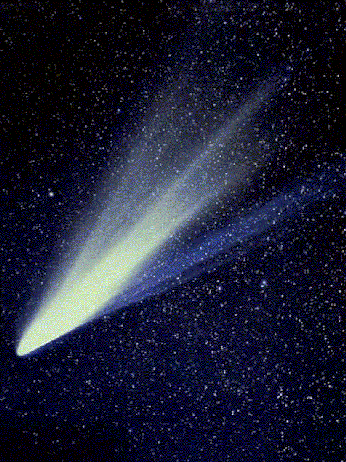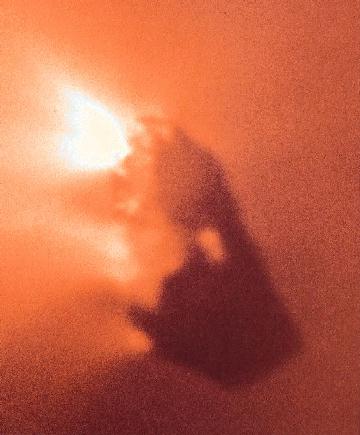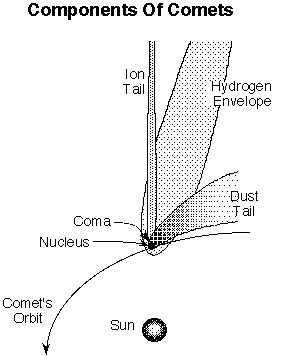
Comet West

Comet West
Comet:
A comet is any of a class of small celestial objects orbiting the Sun and developing diffuse gaseous envelopes and often long luminous tails when near the Sun. Comets are commonly distinguished from other components of the solar system by their rather nebulous appearance and extremely elongated orbits.
The only component of a comet that can be seen with a large telescope when the comet is still far away from the Sun is the nucleus. The cometary nucleus is an irregularly shaped mass composed of ices (largely frozen water) mixed with substantial amounts of sootlike matter--perhaps carbon in the form of fine dust. The first closeup photographs of a cometary nucleus, those of the core of Comet Halley (Halley's Comet) taken in 1986 by the Giotto spacecraft, revealed that the nucleus was very black in colour, with roughly 90 percent of its surface covered by a "crust" of such dust particles.

Core of Comet Halley
Cometary nuclei appear to be quite small in size. That of Comet Halley, for example, is an elongated body measuring only about 15 by 8 km (9 by 5 miles) with an estimated mass of 1017 grams. As the cometary nucleus approaches the Sun, its dust surface becomes hotter, more heat is transferred through the crust, and the subsurface ice begins to sublimate. The resultant gas leaves the comet and carries with it some of the loosely bound dust particles. Sublimation starts when the comets are closer than about three astronomical units from the Sun.
The chemical composition of the vaporizing gases is dominated by water (about 80 percent), followed by carbon monoxide, carbon dioxide, methane, ammonia, and carbon disulfide, quantitatively in that order. Parent molecules leaving the nucleus quickly break up into daughter molecules, radicals, and ions. These absorb solar radiation and subsequently reradiate it at another wavelength. The dust also scatters sunlight. When within 1 AU of the Sun, a typical cometary nucleus is surrounded by a spherical envelope, or coma, of gas and dust, which can be up to 100,000 km (62,000 miles) across. The coma gases travel outward at a speed of roughly 0.6 km per second, dragging dust particles away from the nucleus.

On nearing the Sun, a comet may develop two tails. The solar wind of high-speed protons and electrons sweeps cometary ions in a direction away from the Sun, producing a straight plasma or ion tail. A second tail consisting of dust particles about a micrometer in size may appear. This dust tail has a greater curvature than the ion tail and is usually shorter. The ion tail also points away from the Sun because of the repulsive force exerted by solar radiation pressure on the minute particles. Larger particles released from the nucleus take up orbits that have nearly the same parameters as the parent comet. Some gain on the comet and others fall behind until eventually an annulus of dust is formed around the comet's orbit. This is called a meteoroid stream. A meteor shower is produced in the Earth's upper atmosphere when it passes through such a stream.
Several theories for the origin of comets have been proposed. According to one widely accepted view, comets are as old as the solar system and are the remnants of the building blocks that produced the giant planets. They were gravitationally perturbed by the accreting outer planets into extremely elongated orbits. Hundreds of millions of comet nuclei exist in a spherical region called the Oort cloud that surrounds the solar system. Such nuclei may travel out of the cloud when disturbed by the gravitational force of a nearby star and enter the inner solar system.
Some accretion models of the solar system suggest that an early cometary bombardment of the Earth may have played a major role in the formation of the atmosphere and the oceans. In addition, comets may have supplied the organic molecules needed for life to develop on the planet. Such theories remain unproved.
Comets are generally divided into short-period comets (those with periods of less than 200 years) and long-period comets (those with periods of more than 200 years). Among those comets that can be seen easily with the naked eye, Comet Halley, with an average period of 76 years, is the only one that returns in a single lifetime.
Cometary bodies were investigated for the first time with spacecraft during the mid-1980s. In 1985 the U.S. probe known as the International Cometary Explorer (ICE) passed through the dust tail of Comet Giacobini-Zinner. The following year, spacecraft launched by Japan and the Soviet Union, along with the aforementioned Giotto probe of the European Space Agency (ESA), flew by Comet Halley, transmitting many useful data about its composition and sending photographs of its nucleus and coma.
Excerpt from the Encyclopedia Britannica without permission.